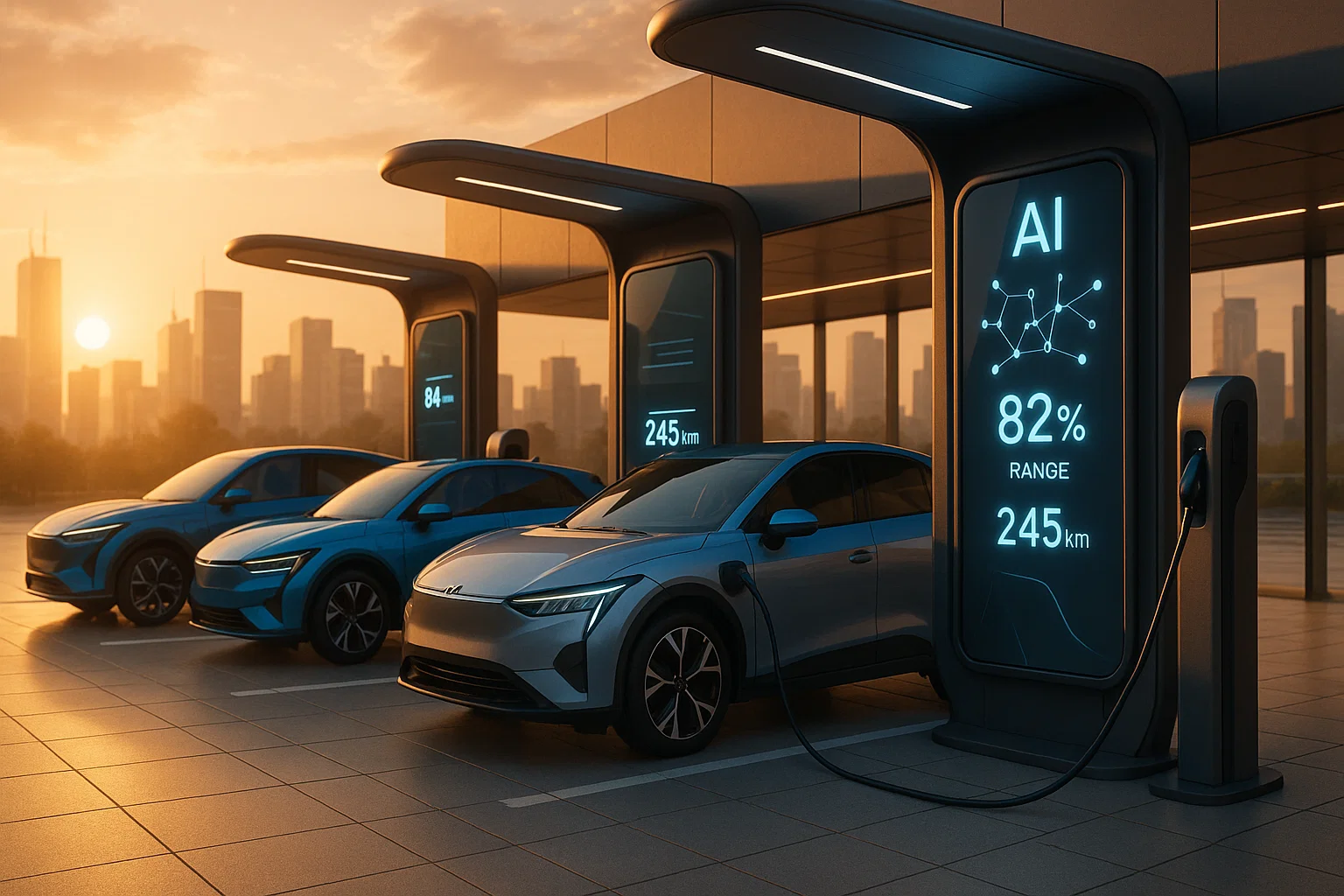 Electric vehicles (EVs) have come a long way from being futuristic novelties to becoming a serious alternative to gasoline cars. By 2025, this transition is no longer “coming soon”, it’s here. From AI-powered driving systems to solid-state batteries and smarter charging grids, electric mobility is undergoing its biggest transformation yet.
Electric vehicles (EVs) have come a long way from being futuristic novelties to becoming a serious alternative to gasoline cars. By 2025, this transition is no longer “coming soon”, it’s here. From AI-powered driving systems to solid-state batteries and smarter charging grids, electric mobility is undergoing its biggest transformation yet.
A 2025 report from the International Energy Agency (IEA) projects global EV sales to exceed 20 million units, a 35% increase over 2024. Meanwhile, more than 200 new EV models are expected to hit the roads worldwide. The shift is being fueled by better technology, lower battery costs, and strong policy pushes across Europe, Asia, and North America.
Here’s what’s changing, and why 2025 marks a defining year for the electric vehicle industry.
Why 2025 Marks a Turning Point for Electric Vehicles
The electric revolution has entered what analysts call the “mass-adoption phase.” Governments and manufacturers alike are pushing hard toward the 2030 zero-emission goals.
1. Global EV Growth and Market Trends
By mid-2025, EVs make up roughly one in every five new cars sold worldwide, according to BloombergNEF’s EV Outlook. China still leads the race with over 10 million annual sales, but Europe and the U.S. are catching up fast thanks to improved affordability and charging access.
In the United States, federal incentives under the Inflation Reduction Act have made EVs more attainable, with up to $7,500 in tax credits for qualifying vehicles. Europe, meanwhile, is moving toward stricter CO₂ limits, forcing automakers to electrify more of their lineup.
2. Infrastructure Expansion
The biggest barrier, charging, is finally being addressed. The European Alternative Fuels Observatory notes that the EU now hosts over 650,000 public charging points, a 45% rise since 2023. Similar expansions are happening across India and the Middle East, where governments are introducing joint public-private charging projects.
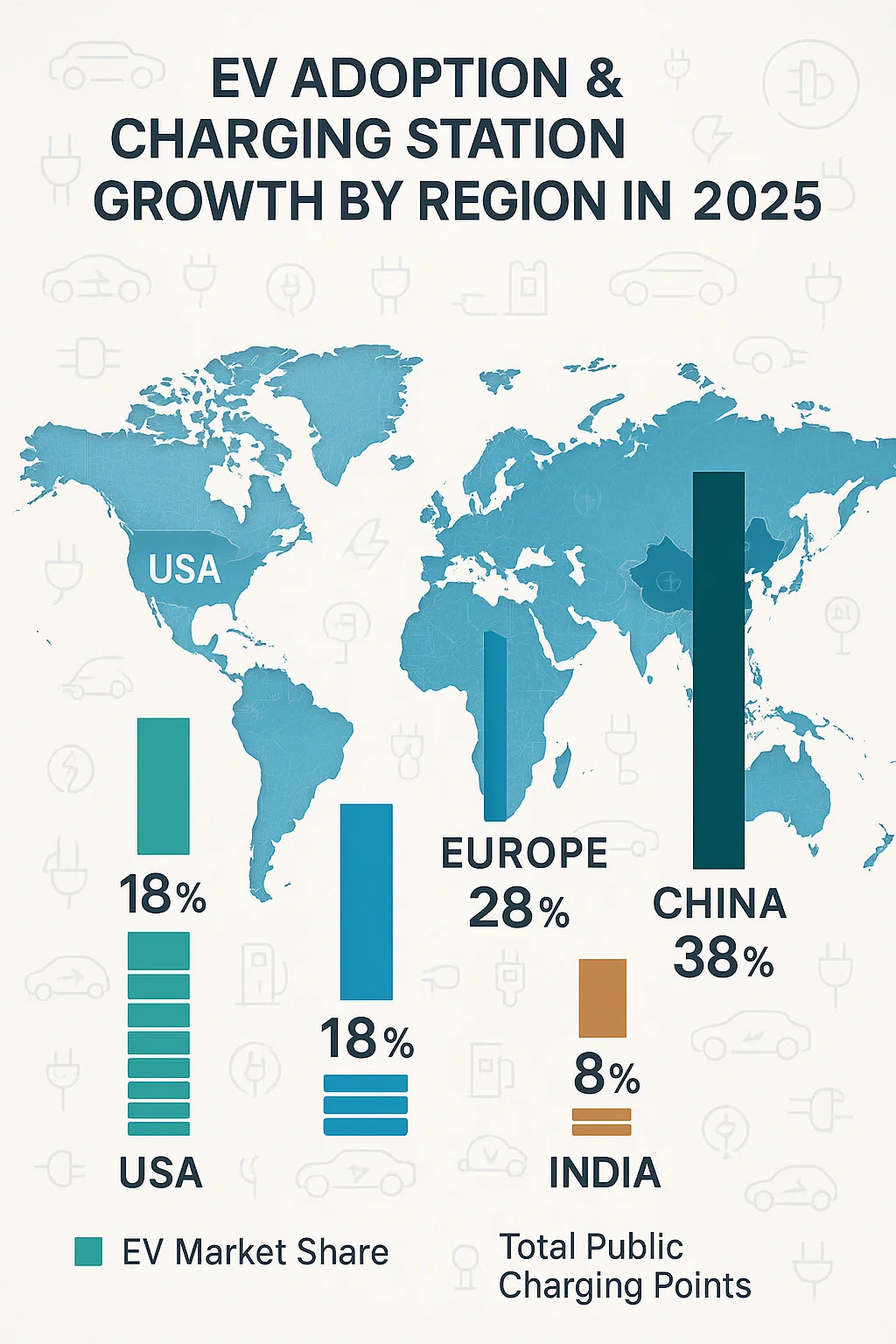
What’s the Latest Technology in Electric Vehicles?
The technology race in EVs today centers around three key areas: batteries, AI, and connectivity. Let’s break down what’s new in each.
1. Solid-State Batteries
Arguably the most anticipated breakthrough of 2025 is the commercial debut of solid-state batteries. Toyota, QuantumScape, and Samsung SDI have announced pilot-scale production this year. These batteries replace liquid electrolytes with solid materials, enabling:
- Faster charging (10–15 minutes to 80%)
- Longer lifespan (up to 800,000 km)
- Greater energy density (up to 50% more range)
According to Nikkei Asia, Toyota’s first solid-state prototype EV will exceed 1,000 km per charge, marking a huge leap for range anxiety.
2. AI Integration
Artificial intelligence is redefining how EVs think and respond. 2025 models from Tesla, Rivian, and Hyundai use AI for:
- Predictive route planning (based on weather and traffic)
- Adaptive energy management
- Real-time battery health monitoring
- Self-diagnosing maintenance alerts
This means EVs are no longer just electric cars, they’re intelligent companions. “We’re entering an age where your car learns your habits, schedules charging times, and optimizes energy use,” says IDC Automotive Research Director Lara Kim.
3. Smart Connectivity and IoT
EVs now connect to everything, from smart homes to city grids. Vehicle-to-grid (V2G) systems allow EVs to return unused power to the grid during peak hours, stabilizing energy networks. Tesla’s Powerwall, Hyundai’s V2L (Vehicle-to-Load), and Nissan’s bi-directional systems are already proving the value of this interconnectivity.
Understanding the 80% Charging Rule for EVs
If you own an EV or plan to buy one in 2025, you’ve likely heard about the “80% rule.” But what exactly does it mean?
Why 80% Is the Sweet Spot
EV manufacturers recommend charging batteries to no more than 80% for daily use. That’s because the final 20% of a lithium-ion battery’s capacity puts significant stress on its chemical cells, shortening its life over time.
Charging from 10% to 80% typically takes only 25–35 minutes on a DC fast charger, while going from 80% to 100% could double that time.
| Battery Type | Optimal Daily Charge | Approx. Lifespan | Notes |
|---|---|---|---|
| Lithium-Ion | 20–80% | 8–10 years | Most current EVs |
| Solid-State | 10–100% | 15+ years | Coming 2025 onward |
| LFP (Iron Phosphate) | 10–90% | 12+ years | Used in budget EVs |
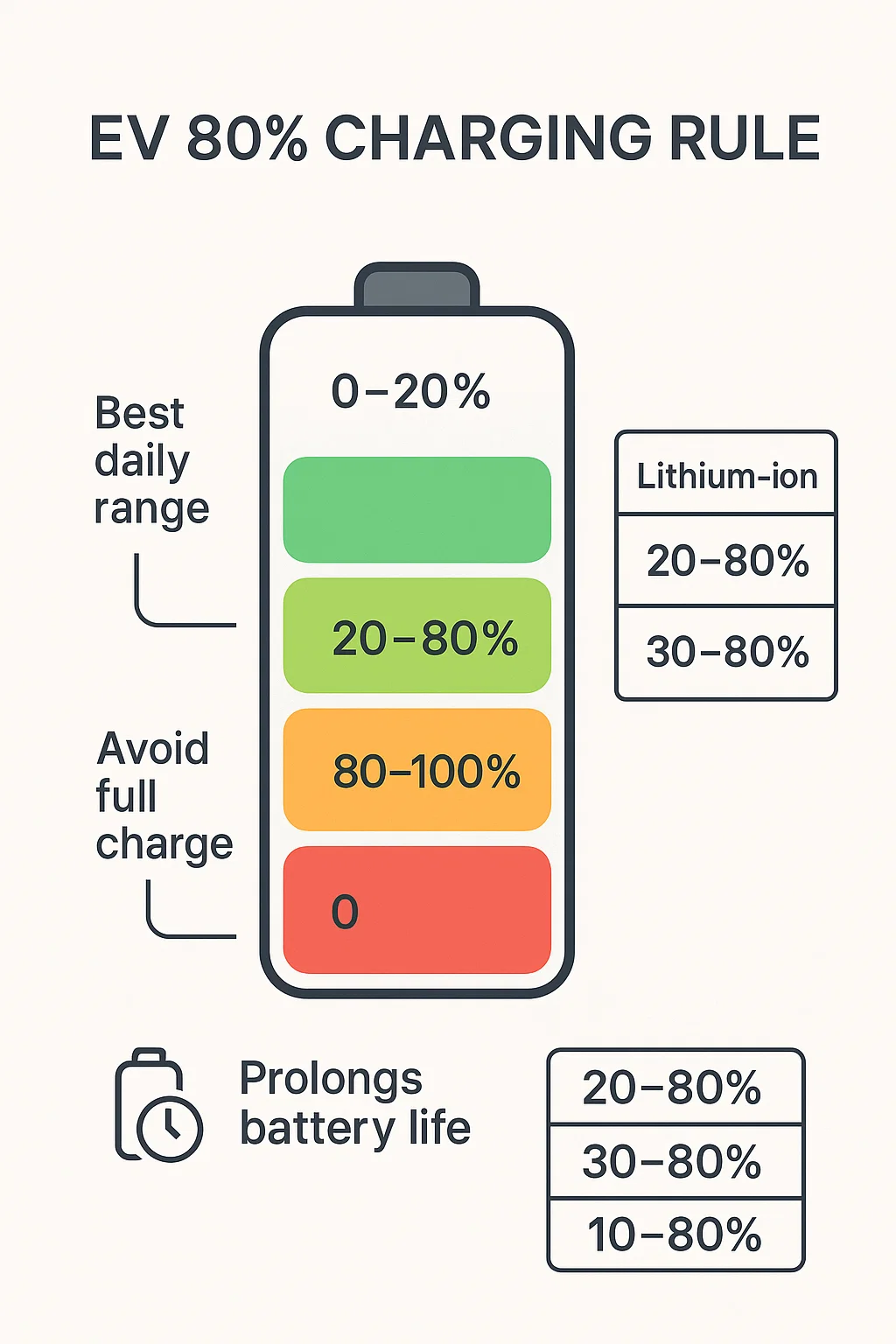
Pro Tip
If you plan a long road trip, charging to 100% occasionally is fine. The key is to avoid keeping the battery fully charged for extended periods.
Major EV Models Coming in 2025
2025 is shaping up to be a banner year for new EV releases. Nearly every major automaker is rolling out next-gen models with upgraded range, performance, and intelligence.
Top Anticipated Launches
| Model | Estimated Range (km) | Battery Type | Highlights |
|---|---|---|---|
| Tesla Model 3 Highland | 600 | Li-Ion | Refreshed design, AI autopilot 3.0 |
| Hyundai Ioniq 7 | 520 | LFP | 7-seater SUV, ultra-fast charging |
| BMW i5 | 580 | Solid-state (optional) | New OS 9 smart interface |
| NIO ET5 Touring | 650 | Semi-solid | Battery swap system |
| Ford Explorer EV | 480 | Li-Ion | Family SUV with BlueCruise assist |
These aren’t just upgrades, they represent an entire ecosystem built around connected, AI-driven mobility.
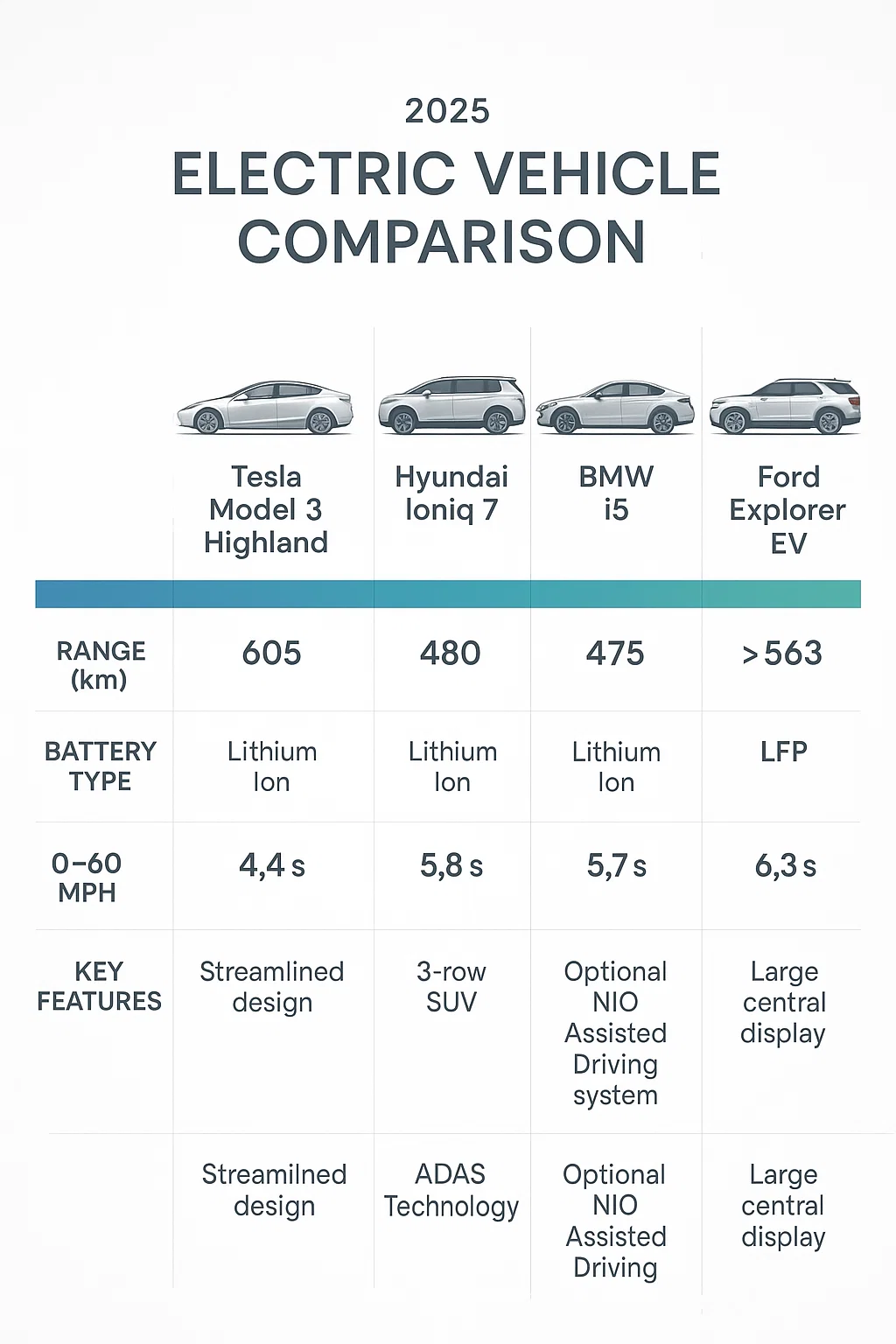
How AI Is Transforming the EV Experience
Artificial intelligence is the brain behind the modern EV revolution. Beyond route planning, AI systems now handle predictive maintenance, driver behavior analytics, and accident prevention.
Self-Driving Maturity
2025 is the year Level 3 autonomous driving becomes mainstream. Mercedes-Benz, Honda, and Tesla have all received approvals for semi-autonomous operations in select regions. Vehicles can now handle highway driving independently while monitoring driver alertness through interior sensors.
Predictive Energy Management
AI systems use cloud data to predict when and where you’ll need power, optimizing battery drain and regeneration. Some cars even learn from your driving style. For instance, Rivian’s 2025 R1T reduces energy consumption by up to 8% using driver-specific AI profiles.
Voice & Emotional Interfaces
Voice assistants like Nissan’s I-Connect or Tesla’s Neural Voice make human-machine interaction seamless. Drivers can ask for the “most energy-efficient route” or “warm cabin by 6 a.m.”
“AI is transforming EVs into partners that adapt, assist, and anticipate,” says Gartner Mobility VP Rohan Patel.
Charging Infrastructure: The Real Game Changer
Technology alone doesn’t drive adoption, infrastructure does. 2025 marks a record investment in EV charging across continents.
Global Fast-Charging Networks
- United States: Over 200,000 DC fast chargers now active, led by Tesla Superchargers and Electrify America.
- Europe: The IONITY network continues expanding, connecting 24 countries with 350 kW chargers.
- Asia: India and Japan push for smart solar-powered chargers to reduce grid pressure.
Wireless and Bidirectional Charging
The latest innovation, wireless charging pads, allows drivers to simply park and charge. Hyundai and WiTricity have introduced residential pads that can fully recharge an EV overnight without cables.
V2G (Vehicle-to-Grid) capability lets EVs double as mobile power banks, feeding electricity back into homes or public grids during peak demand hours, a major step toward smarter, cleaner cities.
The Sustainability Factor: EV Manufacturing and Recycling
The “E” in EV doesn’t just stand for electric, it’s about environmental responsibility.
1. Sustainable Supply Chains
Manufacturers are under pressure to source lithium, cobalt, and nickel responsibly. In 2025, most major automakers, including Volvo, GM, and Ford, now trace raw materials using blockchain verification systems to ensure ethical mining practices.
2. Battery Recycling Revolution
Companies like Redwood Materials (founded by Tesla’s JB Straubel) are pioneering closed-loop recycling, reclaiming up to 95% of valuable metals. China, meanwhile, enforces strict recycling quotas for all EV makers.
3. Greener Factories
Volkswagen’s Zwickau plant and BYD’s Shenzhen gigafactory are now fully powered by renewable energy, setting benchmarks for zero-carbon manufacturing.
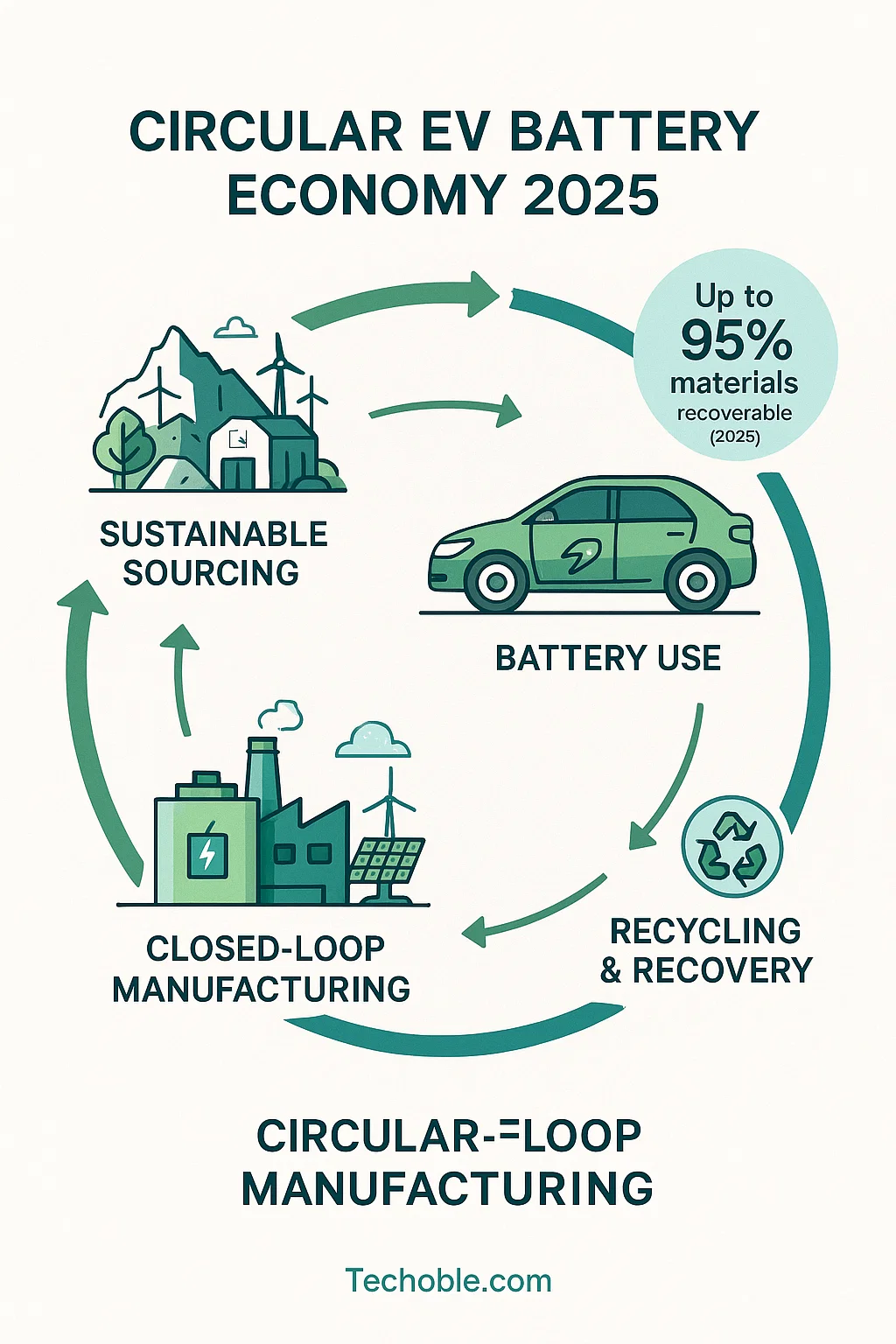
What Is the Current Status of Electric Vehicles in 2025?
Let’s look at where the EV market stands globally right now.
| Region | Market Share (of new cars) | Charging Stations | Leading Brands |
|---|---|---|---|
| China | 38% | 2.1M+ | BYD, NIO, XPeng |
| Europe | 28% | 650K+ | VW, BMW, Renault |
| USA | 18% | 200K+ | Tesla, Ford, Rivian |
| India | 8% | 45K+ | Tata, MG, Mahindra |
While adoption varies by region, the momentum is universal. Costs are dropping fast, the average battery pack price fell below $100 per kWh in 2025, making EVs cheaper to produce than gas cars in many markets.
The only bottleneck? Power grid readiness. Countries are investing in “smart grids” that can handle the added load from millions of new EVs.
Expert Opinions: The Future of EVs Beyond 2025
Industry experts agree that 2025 is the “inflection point.” What happens next will define the next decade.
“By 2030, over half of new cars sold globally will be electric,”
, Fatih Birol, Executive Director, International Energy Agency.
“The next phase isn’t about range or speed, it’s about intelligence. Cars will become data-driven ecosystems,”
, Gartner Mobility VP Rohan Patel.
Looking ahead, we can expect:
- Fully autonomous Level 4 vehicles by 2028
- Solid-state batteries becoming standard by 2029
- Integration of EVs into AI-managed smart grids
These changes will make cars more than transportation, they’ll be moving nodes in a connected energy network.
Practical Checklist for EV Buyers in 2025
Before you buy, here’s what to keep in mind this year:
✅ Battery & Warranty
- Check manufacturer warranty (aim for at least 8 years or 160,000 km).
- Understand the battery type, solid-state, LFP, or lithium-ion, and its charging needs.
✅ Charging Access
- Confirm availability of fast-charging networks in your region.
- Consider installing a Level 2 home charger for convenience.
✅ Software Support
- Look for cars offering over-the-air updates and cybersecurity protections.
- Avoid models with proprietary chargers that may limit compatibility.
✅ Sustainability Rating
- Review manufacturer’s sourcing and recycling policies.
- Prefer brands committed to renewable manufacturing.
✅ Resale and Incentives
- Research local tax credits or rebates.
- Check future-readiness, vehicles that support V2G will hold value longer.
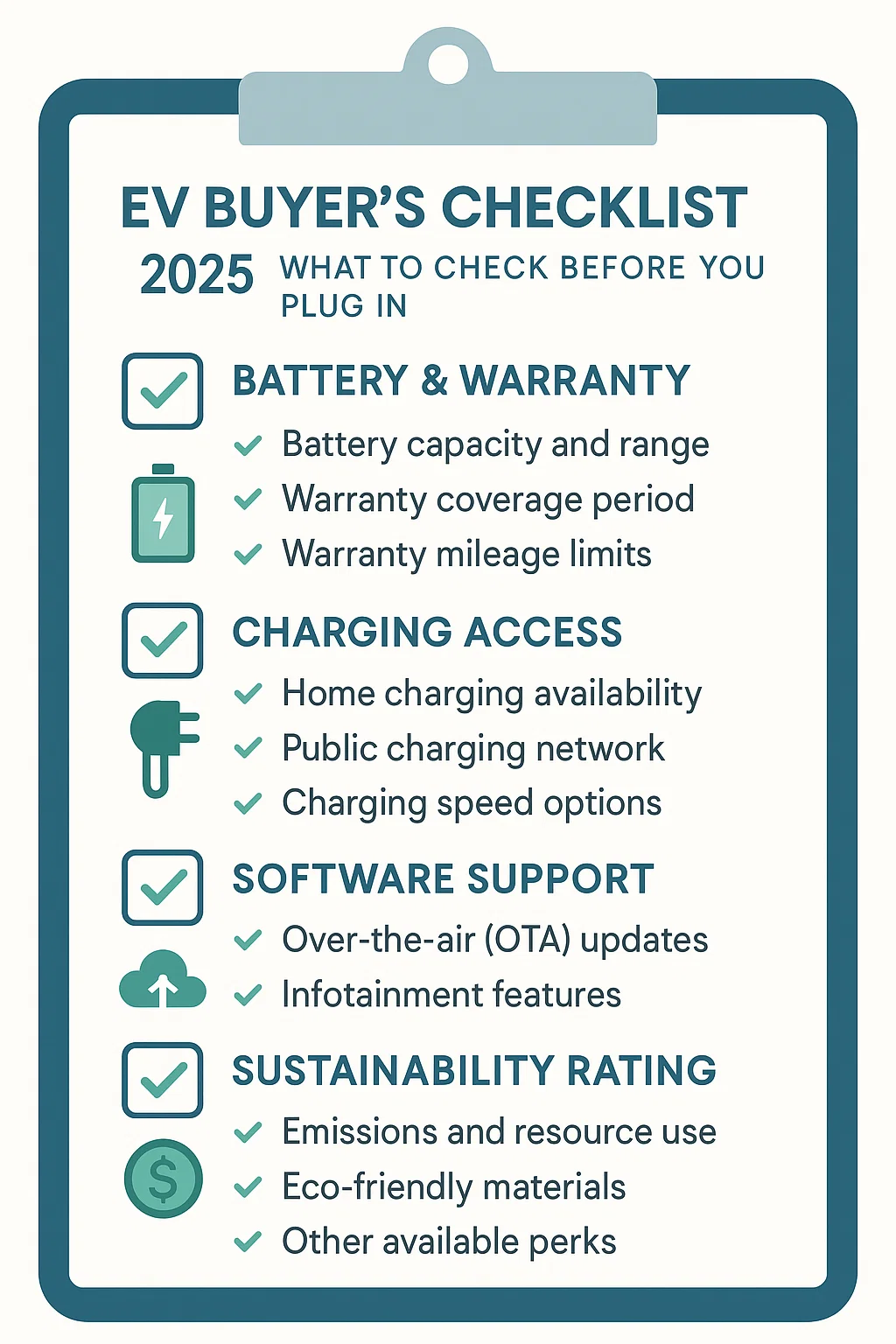
Final Thoughts Before You Plug In
2025 is more than another model year, it’s a milestone in human progress. Electric vehicles are no longer experiments or luxury statements; they’re becoming the default choice for millions.
From AI copilots that learn your habits to batteries that last half a lifetime, the technology powering this revolution is smarter, cleaner, and more personal than ever before.
As someone who has followed AI, IoT, and green tech for years, I see 2025 as the year when EVs truly merge into the intelligent ecosystem we’ve been promised, where mobility, sustainability, and data all connect seamlessly.
So, before you plug in your next car, remember: the future isn’t just electric, it’s intelligent.
Quick Reference: Key 2025 EV Stats
| Category | Highlight (2025) |
|---|---|
| Global EV Sales | 20+ million units |
| Average Range | 600–1000 km |
| Fast Charging Time | 10–25 min (to 80%) |
| Battery Cost | <$100/kWh |
| Charging Stations Worldwide | 3.5 million+ |
| Solid-State Battery Launch | Toyota, QuantumScape |
| Autonomous Level | 3 mainstream, 4 testing phase |
Further Reading & Resources
- IEA Global EV Outlook 2025
- BloombergNEF Electric Vehicle Forecast 2025–2030
- Gartner Mobility & AI Integration Study (2025)
- Redwood Materials Circular Battery Report